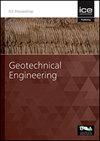Soil resistance during vibratory driving in sand
IF 1.7
4区 工程技术
Q3 ENGINEERING, GEOLOGICAL
Proceedings of the Institution of Civil Engineers-Geotechnical Engineering
Pub Date : 2023-01-20
DOI:10.1680/jgeen.22.00193
引用次数: 0
Abstract
The mechanism that can explain pile shaft resistance during vibratory driving is discussed. One hypothesis is that horizontally oscillating stresses temporarily reduce the shaft resistance. To investigate this hypothesis, vibration measurements were carried out in medium-dense to dense sand during the vibratory driving. A vibrator with variable frequency was used to install a large compaction probe. The driving process and ground response were documented in detail. Geophones were installed on and below the ground surface. Horizontal ground vibrations were measured at three levels below the ground surface. The difference in vibration response of the ground during driving at a high frequency (27 Hz) and at the system resonance frequency (15 Hz) showed the effect of the vibrator operating frequency on penetration speed and emitted ground vibrations. During vibratory driving, horizontal stress pulses are emitted along the probe shaft, which can temporarily reduce static horizontal stresses acting against the probe shaft. This phenomenon can explain the temporary reduction of the shaft resistance and the efficiency of vibratory driving in granular soils. As a result of the horizontal stress pulses, the horizontal stresses are increased permanently. By using a monitoring and process control system, it is also possible to determine the system resonance frequency in the field, which is a critical parameter for vibratory driving resistance, emission of ground vibrations, and vibratory compaction of granular soils.砂土振动掘进过程中的土阻力
讨论了振动打入过程中桩身阻力产生的机理。一种假设是水平振荡应力暂时降低了轴的阻力。为了验证这一假设,在振动驱动过程中,在中密至密砂土中进行了振动测量。采用变频振动器安装大型压实探头。详细记录了驾驶过程和地面响应。地震检波器安装在地表上和地表下。在地表以下三层测量水平地面振动。高频(27 Hz)和系统谐振频率(15 Hz)下驱动时地面振动响应的差异表明,振动器工作频率对穿透速度和发射地面振动的影响。在振动驱动过程中,沿探测轴发射水平应力脉冲,可以暂时减小作用在探测轴上的静态水平应力。这一现象可以解释颗粒土中轴阻力的暂时减小和振动掘进效率的提高。由于水平应力脉冲的作用,水平应力持续增大。通过使用监测和过程控制系统,还可以确定现场的系统共振频率,这是振动驱动阻力,地面振动发射和颗粒土振动压实的关键参数。
本文章由计算机程序翻译,如有差异,请以英文原文为准。
求助全文
约1分钟内获得全文
求助全文
来源期刊
CiteScore
4.40
自引率
4.50%
发文量
68
审稿时长
3 months
期刊介绍:
Geotechnical Engineering provides a forum for the publication of high quality, topical and relevant technical papers covering all aspects of geotechnical research, design, construction and performance. The journal aims to be of interest to those civil, structural or geotechnical engineering practitioners wishing to develop a greater understanding of the influence of geotechnics on the built environment.

 求助内容:
求助内容: 应助结果提醒方式:
应助结果提醒方式:


